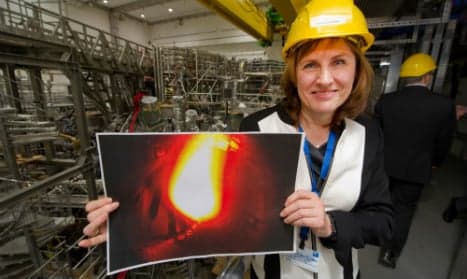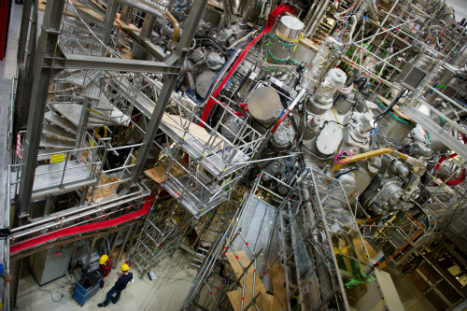German scientists make big stride towards fusion

Scientists in Germany said Thursday they had reached a milestone in a quest to derive energy from nuclear fusion, billed as a potentially limitless, safe and cheap source.
Nuclear fusion entails fusing atoms together to generate energy – a process similar to that in the Sun - as opposed to nuclear fission, where atoms are split, which entails worries over safety and long-term waste.
After spending a billion euros and nine years' construction work, physicists working on a German project called the "stellarator" said they had briefly generated a super-heated helium plasma inside a vessel – a key point in the experimental process.
"We're very satisfied," said Hans-Stephan Bosch at the Max Planck Institute for Plasma Physics in Greifswald.
"Everything went according to plan."
For all its promise, nuclear fusion has proven elusive and highly costly to achieve.
The idea is to heat atoms to temperatures of more than 100 million degrees Celsius (212 million degrees Fahrenheit) so that their nuclei fuse.
The fusion would take place in a special vacuum chamber where the atoms, in a hot ionised gas called a plasma, are held floating in place by superconducting magnets so that they do not touch the vessel's cold sides.

A glimpse at the innards of the Wendelstein 7-X test machine. Photo: DPA
The German experiment, using a machine called Wendelstein 7-X, was aimed at seeing whether it was possible to heat helium atoms with a microwave laser and to briefly contain the plasma within the vessel.
The first plasma in the 16-metre-wide (52-foot-wide) machine, from one milligram of helium gas heated by a 1.8-megawatt laser pulse, lasted one-tenth of a second and reached a temperature of around one million Celsius, the Institute said in a press release.
The fusion reactor race
The team will next try to extend the duration of the plasma and to find out the best way of producing it. Next year, it hopes to switch over to hydrogen, the actual target of the study, as opposed to helium.
Several countries are in the race to build a fusion reactor, including a multinational effort called the International Thermonuclear Experimental Reactor (ITER).
Headquartered in southern France, ITER is building a doughnut-shaped containment vessel called a tokamak.
But plagued by technical problems and cost issues, it has yet to carry out its first experiment almost a decade after the project began.
Other far smaller experimental reactors are also being developed in the United States, but funding has been a problem.
The Wendelstein 7-X will not produce energy.
Instead scientists hope to use it to sustain a plasma for 30 minutes, deemed to be proof that its technology can operate continuously, whereas a tokamak can only run in pulses without auxiliary equipment.
Comments
See Also
Nuclear fusion entails fusing atoms together to generate energy – a process similar to that in the Sun - as opposed to nuclear fission, where atoms are split, which entails worries over safety and long-term waste.
After spending a billion euros and nine years' construction work, physicists working on a German project called the "stellarator" said they had briefly generated a super-heated helium plasma inside a vessel – a key point in the experimental process.
"We're very satisfied," said Hans-Stephan Bosch at the Max Planck Institute for Plasma Physics in Greifswald.
"Everything went according to plan."
For all its promise, nuclear fusion has proven elusive and highly costly to achieve.
The idea is to heat atoms to temperatures of more than 100 million degrees Celsius (212 million degrees Fahrenheit) so that their nuclei fuse.
The fusion would take place in a special vacuum chamber where the atoms, in a hot ionised gas called a plasma, are held floating in place by superconducting magnets so that they do not touch the vessel's cold sides.

A glimpse at the innards of the Wendelstein 7-X test machine. Photo: DPA
The German experiment, using a machine called Wendelstein 7-X, was aimed at seeing whether it was possible to heat helium atoms with a microwave laser and to briefly contain the plasma within the vessel.
The first plasma in the 16-metre-wide (52-foot-wide) machine, from one milligram of helium gas heated by a 1.8-megawatt laser pulse, lasted one-tenth of a second and reached a temperature of around one million Celsius, the Institute said in a press release.
The fusion reactor race
The team will next try to extend the duration of the plasma and to find out the best way of producing it. Next year, it hopes to switch over to hydrogen, the actual target of the study, as opposed to helium.
Several countries are in the race to build a fusion reactor, including a multinational effort called the International Thermonuclear Experimental Reactor (ITER).
Headquartered in southern France, ITER is building a doughnut-shaped containment vessel called a tokamak.
But plagued by technical problems and cost issues, it has yet to carry out its first experiment almost a decade after the project began.
Other far smaller experimental reactors are also being developed in the United States, but funding has been a problem.
The Wendelstein 7-X will not produce energy.
Instead scientists hope to use it to sustain a plasma for 30 minutes, deemed to be proof that its technology can operate continuously, whereas a tokamak can only run in pulses without auxiliary equipment.
Join the conversation in our comments section below. Share your own views and experience and if you have a question or suggestion for our journalists then email us at [email protected].
Please keep comments civil, constructive and on topic – and make sure to read our terms of use before getting involved.
Please log in here to leave a comment.